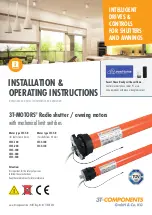
Installation, operation and maintenance instructions
High voltage flameproof motors for explosive atmosphere
AMD Rg 355-400-450-500
Cleaning operations on mechanical parts
Issued by: MOLM
We r
es
er
ve
a
ll r
ig
ht
s i
n thi
s
doc
umen
t a
n
d i
n the
inf
or
mati
on
cont
aine
d
ther
ei
n.
R
epr
o
duc
tion
, us
e
of di
sc
los
u
re
to
th
ird
pa
rties w
itho
ut
ex
pr
es
s auth
or
ity
is
s
trictly f
orbi
dd
en
.
Sheet No.
3AAM101045 E
Rev. B
Page 1 of 2
01.2023
WARNING!
Dismantling and reassembling the explosion proof
equipment (Ex db) requires qualified personnel.
General
Form of the components
Before beginning with the cleaning work, the machine
should be partially dismantled as far as practical
(covers, bearing endshields, bearings, rotor etc.). The
item to be cleaned should always be stripped down
into easily manageable components conveniently
accessible from all sides.
Special machine components
Components of austenitic steel (Cr-Ni alloy, non-
magnetic, corrosion resistant) subject to tensile
stressing e.g. rotor shrink rings, can, in unfavourable
cases, be destroyed by stress corrosion if halogens
cleaning solvents are employed. Therefore, electrical
machines should only be cleaned with non-halogens
solvents.
Cleaning methods
Mechanical dry cleaning
To begin with, one should as a matter of principle
always employ a mechanical cleaning method
(scrapers, hard brushes, vacuum cleaners) to “get the
worst off” or as the main cleaning method. Only
vacuum cleaners with soft suction nozzles of rubber or
plastic should be used.
Wet cleaning
Wet cleaning methods should only be used for the
main cleaning, or for final cleaning after thorough
application of a mechanical cleaning method. The
reason for this is to prevent or at least reduce to a safe
minimum,
undesirable
and
dangerous
dirt
displacement which is liable to take place during wet
cleaning.
Standard cleaning agent
(industrial benzene)
This cleaning agent should be used for ordinary dirt
(dust, oil, slight to medium soot deposits after fire).
Special cleaning agent
(Xylene)
Xylene (higher aromatic value than industrial benzene)
may be required to deal with very gummy oil. It is
usually also the only effective remedy for the sticky
gummy deposits found in a machine which has been
on fire.
In any case the following cautions are needed:
-
The working area should be provided with
particularly efficient ventilation to safeguard health
and as a precaution against fire.
-
The standard relevant safety work must be
applied.
Wet cleaning method
Standard cleaning method
(brush/cloth)
Using the brush, the cleaning agent can only be
applied in relatively small amounts, but it is used to the
utmost for absorbing the dirt.
This is the
standard cleaning method,
whereby the
cleaning agent is applied to the dirt with a hard
paintbrush in small successive stages and the
dissolved dirt immediately wiped off with a clean, dry
cloth, before it has time to start drying or running off.
Only a small quantity of solvent which can be quickly
used up is prepared in a small clean tin.
Consequently,
the
solvent
quickly
becomes
contaminated from the dirty brush and must be
changed very frequently, which also helps to reduce
the fire hazard.
A further important point upon which the effectiveness
of this method depends is that only fresh, clean, non-
fraying and non-fluffing cloths be used and frequently
changed. This requirement must be strictly observed.
Instead of using a large piece of cloth over and over
again as customary, several small pieces should be
prepared and used only two or three times and then
thrown away. This also helps to prevent dirt from being
returned to surfaces being cleaned.
Special cleaning methods
(Spray and jet methods)
Spray and pressure-jet methods may be a more
rational solution where conditions are suitable.
Conventional mobile equipment using aqueous
cleaning agents are available on the market for
pressures up to 90 bar and with heating arrangements
for up to 80°C or steam up to 140°C.
This method can seldom be used on permanently
installed machines, because of the difficulty of
providing an adequate drainage for the substantial
quantity of dirty washing solvent produced. Before
deciding to use any of the special methods available, it
must always be carefully considered whether the
design features of the machine are suitable for such
an application. In addition, the technical department
responsible for the machine and the laboratory
specialist should be consulted.
















































